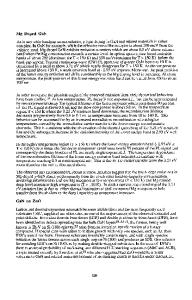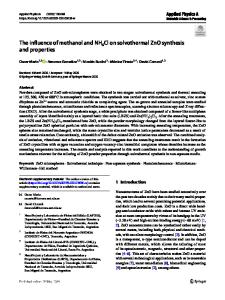Synthesis and properties of nanocoral ZnO structures
- PDF / 1,164,466 Bytes
- 6 Pages / 432 x 648 pts Page_size
- 61 Downloads / 335 Views
Synthesis and properties of nanocoral ZnO structures Micha A. Borysiewicz1, Anna Baranowska-Korczyc2, Marek Ekielski1, Marek Wzorek1, El bieta Dynowska1,2, Tomasz Wojciechowski2, Eliana Kami ska1, Krzysztof Fronc2, Danek Elbaum2, Tomasz Wojtowicz2 and Anna Piotrowska1 1 2
Institute of Electron Technology, Al. Lotników 32/46, 02-668 Warsaw, Poland Institute of Physics, PAS, Al. Lotników 32/46, 02-668 Warsaw, Poland
ABSTRACT Nanocoral ZnO structures are fabricated by means of reactive magnetron sputtering with post deposition annealing. The films are polycrystalline with highly developed surfaces. Their application for biosensing is presented in the extended-gate FET approach where a nanocoral gate electrode is used to sense the pH of the solution and then the presence of BSA molecules. INTRODUCTION ZnO nanostructures gain considerable attention for sensing and photovoltaic applications due to their highly developed surfaces and a significant number of different morphologies reported, ranging from the common nanorods to more exotic structures such as nanoflowers, nanotrees or nanosprings [1-4]. Most of the experimental techniques concerning the fabrication of nanostructured ZnO reported in the literature are chemical solution-based methods where the crystallites precipitate onto substrates in liquid environments [5-7]. Although cost effective and with a low thermal load, the industrial applicability of such techniques for large-scale may be cumbersome with rising issues of reproducibility, solution purity and adequate purging. Recently, we reported a vacuum-based method for nanostructured ZnO fabrication [8] where sputter deposition of porous Zn takes place with subsequent oxidation annealing to form porous ZnO films of nanocoral morphology. This approach not only allows for unprecedented purity and composition control significantly enhancing the reproducibility of the process, but also has the great advantage of being compatible with the standard large-scale coating technology used e.g. for coating architectural glass, which may be beneficial for applications in large-scale photovoltaics or sensors. Using our previous expertise in the area of single electrospun nanofiber-based sensors [910] we decided to study the feasibility of applying the nanocoral ZnO films as gate electrodes in extended-gate FET sensors for biochemical applications [11]. The results of these studies are reported in this communication. EXPERIMENT Nanocoral ZnO (ncZnO) structures were prepared on 4” highly conductive silicon (111) substrates by sputtering of a 3” 4N Zn target in an oxygen-argon mixture (19% O2 content, 1.5 mtorr total pressure) in a Surrey NanoSystems 1000C with a subsequent annealing in an oxygen flow at 600oC. Prior to deposition the silicon was degreased by boiling in organic solvents and cleaned using the standard RCA clean. After sputtering the deposited film is a 3 μm thick porous
113
zinc which has to be oxidized in order to form ZnO as shown earlier [9]. In order to apply the films in the extended-gate configuration,
Data Loading...











